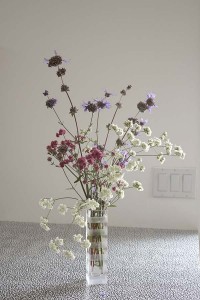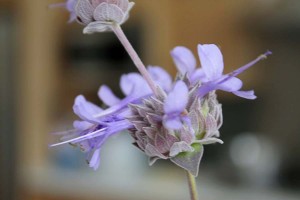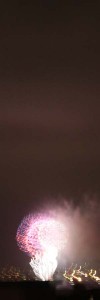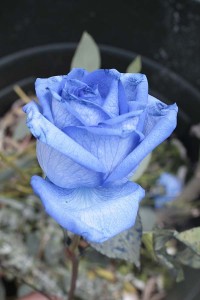We had some people over to view the local fireworks yesterday. To mark the occasion I threw together some of the blooming natives from the garden for a pastel rendition of the red, white and blue theme of the day.
White was the easy color. Several white buckwheats were blooming, and I picked some stems of the flat-top buckwheat, Eriogonum fasciculatum. Its broad, open umbels also look a bit like fireworks.
For red, the dark rose colors of San Miguel Island buckwheat (Eriogonum grande var. rubsescens) provided a reasonable stand-in. If I had some Delphinium cardinale in the garden, it would have really provided a bright scarlet kick. Maybe next year…
For blue, the pickings got pretty slim. The blue-violet whorls of Cleveland sage (Salvia clevelandii ‘Winnifred Gilman’) were the closest I could come up with. As with the white buckwheat, the structure of the stems seemed a bit like fireworks, with whorls of little tubular flowers exploding out from the stem.
The result was a lot less subtle than floral fireworks, but I liked how it marked the occasion and celebrated a Southern California sense of place.
Many of the people who showed up knew I was a plant nut, so two of the hostess gifts were colorful florist bouquets. One of them marked the occasion by including red, white and blue flowers. But even florists with all their international resources sometimes have problems with the color blue. This florist’s solution? Why not dye white flowers blue? The results don’t look much like anything in my California garden so the gift flowers and the local posies weren’t intermixed, and the different bouquets have their own places around the house.
I hope you all had a great fourth!









I really like that buckwheat. Seems like I remember a post you did on it before? It sure does make the perfect white. Happy 4th to you too. Mine was relaxing. Yeah me-I hate fireworks so it did not include them. Your get together must’ve been fun and dyed or not I love the blue rose.
I love your little bouquet of natives. It’s charming. I must admit that florist-dyed flowers in unnatural colors give me the creeps.
Nice flower arrangement. That would have been good with some Triteleia mixed in, but even mine are at the end of their flowering time.
Glad you had an enjoyable celebration!
Hi there, this is OT but I saw your post about using sheet steel for a garden retaining wall:
http://www.soenyun.com/Blog/2008/07/20/beautiful-rust/#comments
I’ve been wanting to do something similar. What type of steel did you use? I see many different types such as galvanized, cold rolled, hot rolled, stainless, etc., and I don’t know what to ask for.
Tina, I did post before on various buckwheats, and concentrated on Saint Catherine’s lace, yet another species. I’ve always enjoyed fireworks, but I also find them a little disturbing at the same time.
Jean, thank you. I wanted to keep it casual and a little naive. I found myself handling the blue flowers at arm’s length, the same way I might handle something that could cause me some harm. It’s an interesting stunt, making them blue, but I’m not sure I love it.
TM, triteleia would have been a nice addition for sure. I can’t believe I don’t have any in the garden. Maybe I can plan better for next year’s bouquets…
Ramesh, I’ll plan on doing a followup post at some point, as my project was an experiment done without any instructions. But to answer your question quickly, I used “mild steel,” and I believe it was hot rolled, though I may be mistaken, in which case it would have been cold rolled. Either will weather to a similar surface. Cold rolled is stronger, but costlier, I believe. Galvanized will have a particular look, as will stainless; neither of them will rust to the same patina that the mild steel will. Both galvanized and stainless will corrode over time, despite their surface treatments or chemical makeup. I used 11-gauge, which is fairly thick and heavy. One problem I’m experiencing is with corrosion from contact with soil. I’ve read of some people coating the inside with fiberglass or an asphalt material to repel water and to reduce contact with the elements in the soil that will speed up corrosion. Avoiding ground contact on the exterior of the container would also lengthen the life of the structure, but that would require laminating an existing wall with steel. One advantage of that would be the possibility of using thinner steel. Good luck with your project!
What a great idea, and the bouquet is lovely. Blue is so abundant in spring–Gilias, Triteleia, various Phacelias–but hard to find by July. For red, I favor Silene laciniata, but you have to plant a lot because it’s anything but dense. There’s also Monardela macrantha ‘Marion Sampson’ but it doesn’t have very long or sturdy stems for cutting. How about planting a Galvezia and snipping off a few stems? Anyway, love the idea of celebrating your own particular place on the 4th!
I used to look at florist’s bouquets and think they were better than the wildflowery ones I occasionally did, but now I don’t really think so. Starting to feel that way about gardens, too, that some of the really well designed ones aren’t any better than the less careful ones. Anyways, nice bouquet, bringing the garden inside.
I have a bride requesting blue roses, I have heard they can be dyed but with just regular frosting dye? Does it effect the longevity and how long before the color took? Thanks for having this, i’ve been looking everywhere!
Donna, I’ve never done it, but yes, it’s possible–and fairly easy–to dye roses blue. Start with white roses and an intense solution of blue food coloring (“intense” as in use an entire bottle of the coloring). Google “dyeing blue roses” and you’ll see several ways you can do this. Be sure to experiment to see which method gives you the results you want.